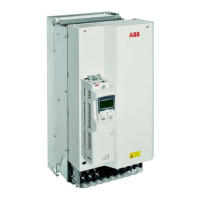Planning the electrical installation
73
Using power factor compensation capacitors with the drive
Power factor compensation is not needed with AC drives. However, if a drive is to be
connected in a system with compensation capacitors installed, note the following
restrictions.
WARNING! Do not connect power factor compensation capacitors or harmonic
filters to the motor cables (between the drive and the motor). They are not meant to
be used with AC drives and can cause permanent damage to the drive or
themselves.
If there are power factor compensation capacitors in parallel with the three phase
input of the drive:
1. Do not connect a high-power capacitor to the power line while the drive is
connected. The connection will cause voltage transients that may trip or even
damage the drive.
2. If capacitor load is increased/decreased step by step when the AC drive is
connected to the power line, ensure that the connection steps are low enough not
to cause voltage transients that would trip the drive.
3. Check that the power factor compensation unit is suitable for use in systems with
AC drives ie, harmonic generating loads. In such systems, the compensation unit
should typically be equipped with a blocking reactor or harmonic filter.
Implementing a safety switch between the drive and motor
It is recommended to install a safety switch between the permanent magnet
synchronous motor and the drive output. The switch is needed to isolate the motor
during any maintenance work on the drive.
Using a contactor between the drive and the motor
Arrange the control of the output contactor by applying one of the alternatives
described below.
Alternative 1:
When you have selected to use the default motor control mode (DTC)
and motor coast stop in the drive, open the contactor as follows:
1. Give a stop command to the drive.
2. Open the contactor.
Alternative 2:
When you have selected to use the default motor control mode (DTC)
and motor ramp stop in the drive, open the contactor as follows:
1. Give a stop command to the drive.
2. Wait until the drive decelerates the motor to zero speed.
3. Open the contactor.

